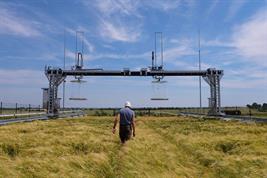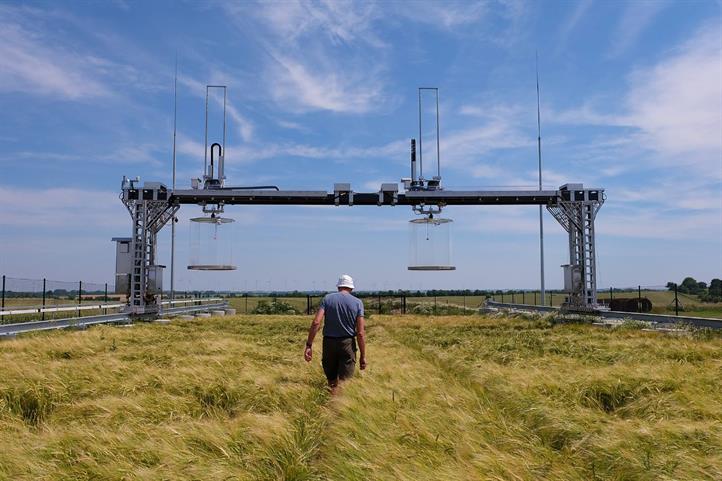01.08.2019
Press Release

At the Leibniz Centre for Agricultural Landscape Research (ZALF), the “Krumensenke” project, coordinated as part of the “Renewable Resources” promotion programme of the Federal Ministry of Food and Agriculture (BMEL), has been launched. In cooperation with the Johann Heinrich von Thünen Institute, research will be carried out over the next three years to find out how the cultivation of raw material plants can be made more climate-friendly through the further development of an almost forgotten method of tillage.
National and international climate targets are difficult to achieve without a contribution from agriculture. More sustainable cropping systems can make an important contribution, specially in the field of arable farming. These would bind more carbon dioxide in soils in the form of humus, store more nitrogen that plants need for growth, and at the same time release less greenhouse gases such as nitrous oxide. The “Krumensenke” project is now investigating whether these goals can be achieved by further developing a specific method of tillage, the so-called ameliorative, fractional deep tillage (aFDT), for the cultivation of raw material plants.
The renaissance of an almost forgotten method of tillage?
“Within ameliorative, fractional deep tillage, which was developed in the 1960s, the soil is cultivated in such a way that stripes are created in the subsoil down to 50 cm depth and subsequently filled with topsoil material”, explains
Prof. Dr. Michael Sommer , who, together with
Prof. Dr. Jürgen Augustin , is heading the ZALF project. These stripes of 10 cm width are repeated in 80 cm distance across a field leaving undisturbed subsoil in between. This is done to reduce the risk of a re-compaction of the subsoil with heavy agricultural machinery. These stripes break through existing compaction zones and allow the crops’ root system unhindered access to water and the nutrients stored in the subsoil. Due to the filling with material from the topsoil, the stripes are stable enough that this type of deep tillage only needs to be applied once, i.e. in an ameliorative way.
The resulting partial deepening of the topsoil has another positive effect: At the beginning of each soil development, carbon (C) and nitrogen (N) accumulate especially in the upper few centimeters of a soil – the pedogenic process of initial humus accumulation. Through the fractional Page | 2 deep tillage, this process is restarted as subsoil material poorer in C and N is mixed into the upper 20 to 30 cm. An imbalance is thus deliberately created in the upper soil zone. It is “unsaturated” with respect to C and N. After a quite short period, organic carbon and nitrogen compounds accumulate here, for example by binding to soil minerals, until the equilibrium is reached again. If there is no degradation of organic matter in the stripes, the topsoil-deepened soils store more carbon and nitrogen in total. For carbon, this means a net CO2 sequestration in the soil.
Research results available to date already show that fractional deep tillage can increase soil fertility and thus yields. The project is now further investigating whether the combination of fractional deep tillage and digestate fertilization can also have a positive influence on the level and the stability of yields in the cultivation of various raw material plants. Digestate is a residual product from the production of biogas. If used improperly, it can lead to environmental pollution, for example through the release of nitrous oxide. A further aim of the investigations is therefore to clarify whether the use of partial topsoil deepening really does bring about the expected reduction in nitrous oxide emissions.
Combination of research approaches
As part of a model experiment in the ZALF Landscape Laboratory (AgroScapeLab Quillow) in the Uckermark, there will be an evaluation of the short-term impact of a targeted mixing of subsoil material into the plough horizon in different soils and variants of nitrogen fertilization on the greenhouse gas fluxes of carbon dioxide, methane and nitrous oxide as well as on the additional storage of C and N in soils. An automated gas measuring system recently co-designed by ZALF is being used, which is based on a mobile gantry crane with mounted gas chambers. In a pilot experiment, the fractional deep tillage is being applied at a representative field of the hummocky ground moraine landscape of north-eastern Germany. In addition, the researchers are testing the long- term effects and sustainability of fractional deep tillage. For this purpose, historical experimental areas on which this method of tillage was used in the 1960s and 1980s will be re-visited and analyzed. The Johann Heinrich von Thünen Institute will carry out the life cycle assessment of the method.
Press Release as PDF
Project Partners:
- Leibniz Centre for Agricultural Landscape Research (ZALF) (coordination)
- Johann Heinrich von Thünen-Institute
Picture
For downloading the pictures please click on a picture and use the icon.


The gantry crane developed by ZALF with automatic gas chambers at the CarboZALF experimental site in the AgroScapeLab Quillow, ZALF’s landscape laboratory in the Uckermark region. The chambers are used to determine the fluxes of greenhouse gases such as carbon dioxide and nitrous oxide depending on soil type, tillage and management. Foto: Julia Lidauer © ZALF
